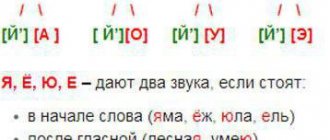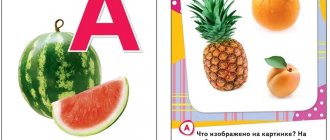What is a syllable?
In speech, all words of the Russian language consist of minimal sounding units - syllables. Let's define what a phonetic syllable is.
A vowel sound forms a syllable. A syllable always has only one vowel. It can independently create a phonetic syllable, as well as in combination with one or more consonants. Consonants are grouped around one vowel sound. In this regard, according to their sound composition, three types of syllables are distinguished:
1. a syllable makes up one vowel sound:
- address
- and -dol
- island
- y-kor
- e-tude
2. a syllable consists of a vowel and a consonant:
- gates
- straw
- magpie
3. a syllable forms a vowel with several consonants:
- dye
- star
- delight
Three syllable words
A word can have more vowels than two. Three vowel sounds combined with consonants form three-syllable words. When pronouncing a three-syllable word, three impulses of air occur, but one of them is stronger, which is created by the stressed vowel, and two are weaker in unstressed syllables. Let's make sure of this by saying the words:
l e -tchi-tsa, k-r about -va , white-li-zn a .
Examples of three-syllable words
In three-syllable words, consonants are grouped with vowels with two, three or even four sounds per syllable, for example:
- do-ro-ga, bo-ro-da, so-ro-ka;
- pri-sta-vka, kra-so-ta, te-le-fon, ka-ran-dash, bu-ma-zhka;
- jump up, shake up, jump up, wait, look.
A vowel can form an independent syllable in a three-syllable word:
- a-ktri-sa, a-zbu-ka, a-na-us, a-ra-his;
- o-city, o-val-ny, o-fresh-to-live, o-tli-chnik;
- u-gol-nik, u-ra-gan, u-chi-tel, u-slit.
Please note that the orthographic transfer of the words given above does not coincide with their syllable division due to the presence of a single vowel in their sound composition.
Let's learn the rule of word hyphenation in Russian.
Let's compare phonetic syllable division and orthographic hyphenation of words:
- u-gorge-e - gorge; a-zbu-ka - az-bu-ka;
- o-go-rod - o-go-rod; u-ra-gan - hurray-gan;
- o-tli-chnik - from-person-nick; a-dre-sat - ad-re-sat.
Open and closed syllables
Syllables can be open or closed. In Russian words, most syllables are open. Open syllables organize
- perch
- a-ir
- swamp
- fiber
Closed syllables form
- nail
- cover
- pigeon
- locomotive
- hundred-rozh
Unpaired voiced consonants [й'], [л], [л'], [м], [м'], [н], [н'], [р], [р'] can form a closed syllable in any phonetic positions: at the beginning, in the middle and at the end of words:
- mirror
- bo l -tik
- sa-ra y-chik
- sa-ra-fa n
How to correctly divide words into syllables?
Words are divided into phonetic syllables according to the number of vowel sounds. A word contains as many syllables as there are vowels. One vowel sound surrounded by consonants creates a monosyllabic word that is not divided into syllables:
- som
- mole
- waltz
- ford
To be able to divide a word into syllables, it must have at least two vowel sounds that form two-syllable words:
- hedgehog
- do-mik
- salad
- rabbit
If a sonorant consonant is between two vowels, then
- crow
- cool he
- bark
- klan-ya-tsya (-tsya sounds like [tsa])
When dividing into syllables, we take into account that the syllable ends with a vowel, and the group of subsequent noisy consonants, in combination with or without a sonorant sound, moves off at the boundary of the syllable division to the next phonetic syllable:
- no-chnik
- roof
- cork
- Creation
Only unpaired voiced consonants in the middle of a word can close a syllable:
- alphabet
- construction
- qua r-tal
- la n-dy-she-vy
- b-sshu m-ny
If a word has the same consonants, then they begin the next phonetic syllable:
- program
- te-nnny-sny
- sneakers
- parallel
This division into syllables is phonetic, which does not coincide with the orthographic hyphenation of words with double consonants.
The letters “й”, “ь”, “ъ” belong to the syllable after which they are written:
- re y-ka
- flakes
- from ъ-ezd
- under the
Let us indicate the order in which words are divided into syllables using the following algorithm.
Four syllable words
If the sound form of a word contains four syllabic vowels, we will call it four-syllable, for example:
- a-za-li-ya, a-lu-mi-niy, a-ra-be-ska;
- ka-ley-do-skop, rat-so-lo-vka, hundred-ro-zhe-howling, le-ni-vi-tsa;
- o-sta-no-vka, o-va-tsi-ya, o-pe-ra-tor;
- u-chi-li-sche, u-kla-dchi-tsa, u-ro-zha-ny.
The transference of these words also requires care. When translating four-syllable words, one letter cannot be left on the line or transferred to the next line, although the phonetic syllable exists independently in it.
Let's compare:
- u-ro-zhay-ny - harvest-y, fruitful;
- o-va-tsi-ya - ova-tsiya;
- a-lu-mi-niy - aluminium-minium, aluminum-niy.
Four-syllable words are not the limit in phonetic composition. In the Russian language there are five-, six-, seven-syllables, etc. words, for example:
- five-syllables - u-kra-she-ni-e, for-ya-vle-ni-e, ma-te-ma-ti-ka, fur-ha-ni-che-sky;
- six-syllables - pre-o-bla-da-ni-e, po-be-di-tel-ni-tsa, per-re-po-ya-sa-ny, po-la-ri-za-tsi-ya;
- seven-syllables - mi-ne-ra-liza-tsi-ya, with-so-e-di-ne-ni-e, re-ko-gno-sci-ro-vo-chny.
Previous
Hyphenation of wordsDisyllabic words are... Division into syllables (examples)
Next
Hyphenation of words Which words cannot be divided for hyphenation?
Algorithm for dividing words into syllables
- read the word;
- Let's emphasize vowel sounds;
- count the number of vowel sounds;
- let's see if the word has double consonants, unpaired voiced consonants, “ь” or “ъ”;
- Let's divide the word after each vowel into syllables, taking into account the indicated features.
Examples
This word has 4 vowel sounds that form the same number of syllables. A soft dividing mark is written in the middle. Let's divide the word into four phonetic syllables. We will leave a soft sign after the consonant indicated by the letter “v”:
In this word, two syllables are open, and the third and fourth syllables are closed, respectively, by a voiced consonant “v” and an unpaired voiced consonant, indicated by the letter “y”.
In accordance with this division into syllables, we transfer this word from one line to another in three ways:
- owl
- nightingale
- nightingale
In this word we indicate 4 vowel sounds that organize four phonetic syllables:
All syllables are open. The first and last syllables form vowels independently. The third syllable consists of a vowel with noisy consonants.
In accordance with this phonetic syllable division, the word cannot be transferred, since one letter, even constituting a syllable, does not remain on the line and is not transferred to the next one. Let's attach them to the next and previous syllable and get the correct version of word transfer by syllables:
Two-syllable words
According to the number of syllables, words can be polysyllabic: two-, three-, four-syllable, etc.
Two-syllable words, as can be determined by their name, contain two vowel sounds, for example:
sli-va, chair-chick, fence, city, crown, te-ma, u-kaz, island, a-gent, i-gla, snake-ya, evening.
When pronouncing them, the chin will fall onto the palm twice, as there will be two shocks of exhaled air.
We will learn about how to divide words into phonetic syllables and what needs to be taken into account with examples in the article about two-syllable words.
Not all two-syllable words can be transferred from one line to another in accordance with phonetic syllable division. A number of words in which a single vowel forms an independent syllable cannot be transferred, leaving one letter on the line, for example:
- snake-me - snake
- u-dar - blow
- o-braz - image
- i-gla - needle
- a-nis - anise.
Did Clara steal or steal the clarinet? 40 verbs in which we put the accent incorrectly
Few today can boast of knowing where the emphasis should be in the verb “to cork,” but that’s not so bad: how many times have we stumbled over words like “removed” or “removed,” “sorted out” or “sorted out”? For those who want to solve this issue once and for all, we are publishing an orthoepic guide from Tatyana Gartman, a teacher and author of the book “The Word is Not a Sparrow,” which was published by the Bombora publishing house. Study it and you will know how to correctly pronounce the most commonly misspelled verbs.
In the Russian language there are verbs that are really difficult in terms of pronunciation, in which the stress is in an unexpected place, for example “zakuporit”, “premium”, “scoop”. We don't use these words very often, at least not every day.
But there is a group of the simplest verbs that we use constantly, several times a day, or even an hour, but we pronounce them at random, as it goes (or doesn’t go): sometimes right, sometimes wrong. I would like to stop this vicious roulette and place the emphasis as it should. And the focus was on past tense verbs.
Reading in sentences
Having mastered reading words, move on to sentences and then to short texts. There are special editions for children starting to read. It is important that reading is enjoyable for the child, challenging but doable.
What difficulties most often arise at this stage?
Sound fusion. If the child pronounces each sound separately, but cannot pronounce it together, draw a path and write two letters of the syllable along the edges. Place your child’s finger on the first sound, pull it while you “run” along the path to the second. Extend the sounds with your child, show how they merge into a word.
Regressions. These are recurrent eye movements for the purpose of re-reading what has already been read. To avoid forming the habit of reading and pronouncing a word several times, carefully observe how your child reads. Do not rush to move from syllabic reading to reading words, otherwise the child will get used to first reading to himself syllable by syllable, and then reading the whole word out loud.
Anticipation. This is the name of a semantic guess, the ability to assume the logic of a text. A very useful skill, but in the first stages of learning to read it leads to mistakes. The child, in a hurry to read the word and get approval, “omits” the endings, having read only the first syllable, “finds out” the word. To overcome such mistakes, suggest games with words, for example, reading “gibberish” poems - a set of rhyming combinations of sounds. And again, do not “press” your child in mastering the skill of reading. This is a long and complex process.
Try to immediately orient your child toward meaningful reading. Before reading, look at the illustrations, read the title, guess what the text is about, ask questions. While reading, ask clarifying questions to understand what you have already read, clarify the meaning of new words. After reading, discuss who you read about and what he/she does. Draw and act out the stories you read.
To overcome slow reading, develop your child’s memory and attention. Play with words and with words, expand your vocabulary. The success of learning to read is determined by the development of thinking, memory and speech, formed by motivation.
Exceptions... Where would we be without them?
In addition to the previous list, we need to consider a few more monosyllable words. There are three exceptions among these verbs, for which an even simpler scheme works: in them the stress is unchanged, and in the feminine it remains on the stem. These are the words.
put - put, put, put, put
steal - steal, steal, steal, steal
stlat - stal, stla, stal, stal
And in confirmation, let us remember the tongue twister known to everyone from childhood about a criminal duet. In it, Clara did not steal the clarinet, but stole it.
Karl stole corals from Clara, and Clara stole a clarinet from Karl. If Karl had not stolen corals from Clara, then Clara would not have stolen the clarinet from Karl.
There is somewhere to roam
Let's complicate the task a little. Let's look at two-syllable words with prefixes that are not used without prefixes. This group includes Gorbachev’s famous begin, or rather, begin, as well as other words ending in -nyat, -start, with different prefixes.
The same rule applies here: in the feminine gender we have a stressed ending, in other forms we have a stressed stem.
A slight difference compared to monosyllabic words is that the stress in the initial form is on the second syllable, while in other forms (except for the feminine gender, of course) it is transferred to the prefix.
borrow - borrowed - borrowed - borrowed - borrowed
hire - hired - hired - hired - hired
start - started - started - start - started
accept - accepted - acceptedA - accepted - accepted
Sometimes these verbs are also not taken seriously, and there are many more variants of distorted words, because there are more syllables, which means there is room to roam: accepted, acceptedO, began, occupied...
And here, too, double standards have been introduced in some words, which further simplifies the already simple rules.
hug - hugged - hugged - hugged - hugged
take away - Took away - took away - Took away - Took away
lift - raised - raised - lifted - lifted
By the way, these double standards were introduced recently. Lately, I’ve often heard a new farewell from men: “Hugged!” instead of “Bye!” with emphasis on the first syllable. Poets of the end of the last century also used past tense verbs according to classical rules, and this is pleasant.
I hugged those shoulders and looked at what was behind me, and saw that the pulled out chair was merging with the illuminated wall.
I. Brodsky
Possible fluctuations
The next small group of problematic verbs is very similar to the previous one. Next up are verbs with prefixes, and the only difference from the words of the previous section (take, start) is that these words can be used without prefixes: live (live), tear (tear).
As for the stresses in the past tense, they are almost the same: in the feminine gender on the ending, in other forms on the base. It is on the basis, but fluctuations in stress between prefix and suffix are possible.
come to life - come to life - come to life - come to life - come to life
break through - broke through - broke through - broke through - broke through
torn off - tore off - tore off - tore off - tore off
I especially draw attention to the most common mistakes: “the pipe burst” (and not burst and did not burst), “the roof was torn off” (and not torn off and tore off), “the flower came to life” (and not came to life).
The storm has passed. And the discordant hubbub of birds came to life again in the forest. And the pine forest breathes moisture, And the lightning flashes fade.
S. Mikhalkov
And according to the tradition of this chapter, in some words we again receive bonuses, or rather a double rate.
pour - poured - poured - poured - poured
sell - sold - sold - sold - sold
Reflexive verbs are forgotten forever
Let’s complicate our verbs a little more - add the reflexive suffix “-sya” to them. And in reflexive verbs, the emphasis most often moves to the ending, and in all forms where this ending is present. In the masculine gender the ending is zero and the stress fluctuates between suffixes - reflexive and non-reflexive.
get busy - got busy - got busy - got busy - got busy
hire - hired - hired - hired
begin - began - began - began Axis - began
accepted - accepted - accepted - accepted Axis - accepted
There are songs that everyone knows, and the most striking example is the song about the Christmas tree. It begins with the words “A Christmas tree was born in the forest,” and previously the word “born” with an emphasis on I was a mistake; only “born” corresponded to the norm.
However, the Russian language does not stand still, and new double standards have now been introduced, which have saved the famous song from an unpleasant error. And not just a song! There are quite a lot of words with double accents. Even the incomplete list of amnestied verbs looks impressive.
take on - took on - took on - took on - took on
dig in - dug in - dug in - dug in - dug in
WAIT - WAIT - WAIT - WAIT - WAIT
wonder - wonder - wonder - wonder - wonder
get drunk - got drunk - got drunk - got drunk - got drunk
sort it out - sort it out - sort it out - sort it out - sort it out
born - born - born - born - born
fight - got into a fight - got into a fight - got into a fight - got into a fight
get ready - got ready - got ready - got ready - got ready
The option with an accent on the ending still seems preferable to me, and it is very pleasant that this particular norm has been preserved in classical poetry.
Dividing words into syllables
In speech, all words of the Russian language consist of minimal sounding units - syllables. Let's define what a phonetic syllable is. Definition A phonetic syllable is the smallest unit of speech made up of a vowel sound or a vowel with one or more consonants. The syllable is pronounced with one impulse of exhaled air.
A vowel sound forms a syllable. A syllable always has only one vowel. It can independently create a phonetic syllable, as well as in combination with one or more consonants. Consonants are grouped around one vowel sound. In this regard, according to their sound composition, three types of syllables are distinguished:
1. a syllable makes up one vowel sound:
- address
- idol
- island
- reproach
- etude
2. a syllable consists of a vowel and a consonant:
- gates
- straw
- magpie
3. a syllable forms a vowel with several consonants:
- dye
- star
- delight
Monosyllabic words
Based on the minimum number of vowels in a word, we select monosyllabic words that contain one phonetic syllable. Let's remember what a phonetic syllable is.
A phonetic syllable is one vowel sound or a vowel combined with one or more consonant sounds, which in the process of speaking are pronounced with one impulse of exhaled air.
Place your palm under your chin and clearly pronounce the words:
manhole, march, elk, bridge, leaf, moment, cheese, test, look.
On vowels, the chin will hit the palm once. This means that these words are monosyllabic.
Let's learn in more detail about the composition of monosyllabic words with one, two, three, four consonants.
Open and closed syllables
Syllables can be open or closed. In Russian words, most syllables are open. Open syllables organize
- perch
- a-ir
- swamp
- fiber
Closed syllables form
- nail
- cover
- pigeon
- locomotive
- hundred-rozh
Unpaired voiced consonants [й'], [л], [л'], [м], [м'], [н], [н'], [р], [р'] can form a closed syllable in any phonetic positions: at the beginning, in the middle and at the end of words:
- mirror
- Bol-tick
- sa-ray-chik
- sa-ra-fan
Syllable emphasis
Below we describe general approaches to highlighting syllables in words for the traditional school and with in-depth study. For detailed materials with explanations and examples, see the rules page for dividing words into syllables.
Traditional school
The main rule of the regular school curriculum, which the child is guided by: as many vowels, as many syllables. When translating words, they are guided by the rules: we transfer the word by syllables, you cannot leave one letter on a line. Everyone knows these rules.
When dividing a word into syllables, you can use the push method: we place our palm to our mouth and feel the push of air as we pronounce the word. Or we imagine a candle in front of us: the number of times the flame flickers, the number of syllables. For some words with flowing consonants, this option is not always suitable.
The principles of teaching division into syllables vary in different primary schools. In some schools, they are taught to visually divide a word into parts - vowel + consonant connectives (or vowel + several consonants). Other schools teach how to pronounce a word with pauses in a convenient way. Pauses create places for dividing syllables.
School of Advanced Study
In schools for in-depth study of the Russian language and in institute programs, cases are dealt with when words are not transferred into syllables, that is, the syllable of transfer does not coincide with the phonetic syllable.
The division of a word into syllables occurs in such a way that the syllable is pronounced in increasing order: from voiceless pronunciation to voiced pronunciation. Therefore, syllables consisting of several sounds always begin with a voiceless consonant and end with a vowel. For example: by mail (but not by mail), mo-shka (but not by mosh-ka). A syllable can end with a voiced consonant (sonorant r, l, m, n), which sounds less sonorous than a vowel, but louder than a voiceless consonant. For example: bun, cook.
How to learn letters with your child
After the child has learned to distinguish the sounds that make up words, we move from sounds to letters.
As a rule, there are no difficulties with learning the alphabet. Children readily remember letters and remember their names. You can use magnet letters, sticker letters, letters made from various materials - rough, smooth, soft. Place them on a special board, tablet, allocate space on the nursery wall, on the refrigerator, on the cabinets.
Collect a piggy bank for each letter: these can be objects whose names begin with that letter. Go through the toys, you will probably find suitable objects: “A” - angel, orange, “I” - apple, “K” - cube, pencil, “B” - bulldozer, banana. Clap the syllables as you pronounce the words. Offer your child objects and discuss together whether this letter will be “friends” with him. It is still difficult for the child himself to find the right word, but be sure to support the initiative shown, remembering the principle: do it together, but not instead.
Consider the letter. What does she look like? What parts does it consist of? Imagine with your child together: “B” looks like glasses, “E” looks like a brush. What does the letter "M" look like? Look at the pictures in which the letters are “hidden”. Fold letters from cereals, buttons, sculpt from plasticine, clay, draw in different colors. The goal is to teach the child to recognize the graphic appearance of letters and relate them to the sound they represent.
It is not recommended to study letters in alphabetical order. Currently, there are two main principles for studying the alphabet.
Frequency (V.G. Goretsky). First, the most common sounds are studied, then the less common sounds, and finally, a group of less common ones is introduced.
Positional principle (D.B. Elkonin). Sounds are studied in pairs, in accordance with the phonetic system of the Russian language: vowels “A” - “I”, “O” - “E”, paired consonants: “S” - “Z”, “D” - “T”, etc. d.
How to correctly divide words into syllables?
Words are divided into phonetic syllables according to the number of vowel sounds. A word contains as many syllables as there are vowels. One vowel sound surrounded by consonants creates a monosyllabic word that is not divided into syllables:
- som
- mole
- waltz
- ford
To be able to divide a word into syllables, it must have at least two vowel sounds that form two-syllable words:
- hedgehog
- do-mik
- salad
- rabbit
If a sonorant consonant is between two vowels, then
- crow
- pendant
- covet
- cla-nya-tsya (-tsya sounds like [tsa])
When dividing into syllables, we take into account that the syllable ends with a vowel, and the group of subsequent noisy consonants, in combination with or without a sonorant sound, moves off at the boundary of the syllable division to the next phonetic syllable:
- no-chnik
- roof
- cork
- Creation
Only unpaired voiced consonants in the middle of a word can close a syllable:
- alphabet
- construction
- quarter
- lan-dy-she-vy
- silent
If a word has the same consonants, then they begin the next phonetic syllable:
- program
- te-nnny-sny
- sneakers
- parallel
This division into syllables is phonetic, which does not coincide with the orthographic hyphenation of words with double consonants.
The letters “й”, “ь”, “ъ” belong to the syllable after which they are written:
- rail
- flakes
- departure
- lifting
Let us indicate the order in which words are divided into syllables using the following algorithm.
How to divide a word into syllables with a combination of consonants
How to divide a word into syllables if there are several consonants nearby in the middle? How to correctly break a word into syllables: cat or cat? You need to understand the principle of so-called greater sonority. It is observed in the second case. From consonant to vowel. First there is a dull sound, then a voiced consonant, and at the end a vowel - shka. The first syllable ends with a vowel (ko). Such syllables are called open. We have much more of them than those that end with consonants: table, chair (they are called closed syllables).
In the middle of a word, the syllable is usually open, that is, it ends with a vowel sound: stra-na. According to the principle of increasing sonority, all consonants move in most cases to the subsequent syllable: cat.
If several consonants are combined in the middle of a word, then all the consonants following the vowel go to the next syllable: o-flow. These can be the same consonants or simply combinations of different consonants: o-flow, sha-pka, ko-shka.
An exception to this point: only those syllables in the middle of a word that end with unpaired consonant voiced sounds (they are called very voiced, sonorant) end with a consonant: [й], [р], [р'], [л], [л '], [m], [m'], [n], [n']: may-ka, San-ka, man-ka.
If in a word several sounds merge into one sound, then they all go to one syllable: zhu-zhzh (Zh)at, distracted (CA). In these cases, one should not confuse division into syllables and morphemic division for transferring a word: for example, we divide o-teket by syllables, but for transfer we divide the same word like this - ot-tek.
How to teach a child to read syllables
Whatever sequence you follow when introducing your child to vowel letters, tell them that these letters not only represent the vowel sound, but also tell you how to read the consonant that comes before them.
After learning several letters, for example, “A”, “I”, “O”, “E”, “M”, “N”, “L”, “S”, “K”, try to read syllables and short words. Before reading a syllable, look at the letter representing the vowel. What work does it do: softens the consonant or indicates its hardness?
Compare the consonant sounds in the words “CAT” and “WHALE”. What sound does the letter “K” make in both words? Which letter suggests that “K” is pronounced softly? Reason with your child: in the word “CAT” the letter “O” denotes the vowel sound “O”, it does not soften the consonant, so we pronounce the hard sound “K”. In the word “KIT” the letter “I” indicates softness; we pronounce the sound “K” softly.
When reading words, guide your child to the vowel. Vowels denoting the softness of the preceding consonant: “I”, “E”, “Yo”, “Yu”, “I”. Next, suggest words with the letter “b” at the end of the word, it also indicates softness, but is not pronounced: HORSE, ELK, GOOSE. Having mastered the principle of merging a consonant with a vowel and ways of indicating softness in writing, the child will be able to read any word, knowing what sound a particular letter represents.
The principle of complicating words for reading is the same as when studying sounds: from monosyllabic words with clearly audible sounds - to words whose spelling matches the sound, and words whose spelling and sound do not match.
Stay at this stage. Do not rush to read sentences and text. Play with words. Collect words from cards with syllables, find “extra” words by different bases, for example, shortest/longest, by number of syllables, by meaning - TABLE, SPOON, BED, etc. Suggest words that differ in one sound: LUK - LUK, accent: LOCK - LOCK, find hidden words in the word: RHINO, SAND, PIN and the like. Read word slides: the first word consists of two letters, the second of three, and so on. Such game tasks will help strengthen the skill of syllabic reading and prepare for reading complex and new words.
Why be able to divide a word into syllables?
Isolation of syllables is important for the correct hyphenation of words; the syllabic principle is the main one in competent hyphenation, although not the only one. Both skills are important: identifying syllables in a word and the ability to find morphemes (meaningful parts of a word), because syllables and morphemes in many cases do not coincide. The syllable is not a prefix or root, or a suffix.
Division into syllables occurs when a word is pronounced. And dividing a word into parts is necessary for writing a word, that is, for writing letters in prefixes, roots, and suffixes.
Isolation of morphemes (prefixes, suffixes, roots) and syllables are two different actions, two different principles on the basis of which competent transfer of words is carried out.
For example, when transferring a word syllable by syllable, you need to simultaneously see the root and prefix, so that, for example, you do not tear off the first and last letter of the root or break a monosyllabic prefix.
There are a number of transfer rules that rely on the ability to divide a word into syllables and morphemes at the same time. Therefore, you need to be able to do one and the other.
When should you teach your child to read?
When to start? One child already knows the entire alphabet at the age of three, while another begins to show interest in books only at the age of five. It's not a matter of age, but a child's readiness to master literacy. Key indicators of such readiness:
- the child speaks in separate sentences;
- pronounces most sounds clearly;
- can consistently tell how he spent the day in kindergarten or visiting his grandmother;
- navigates in space, knows the concepts of “left”, “right”, “up”, “down”;
- holds attention, can do one thing (draw, sculpt, assemble a construction set, etc.) for 10–15 minutes.
Teaching a child to read should begin not with letters, but with sounds. It is sounds that he hears from birth, and letters are a means of recording sounds. Having learned to distinguish sounds in spoken words, merge sounds into syllables, and divide words into syllables, the child will easily master reading.







